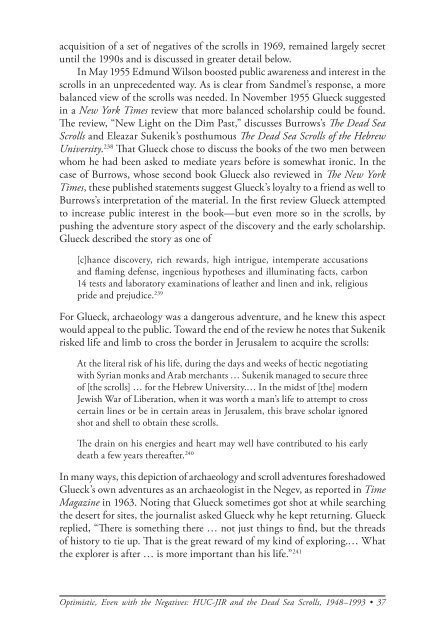The American Jewish Archives Journal, Volume LXI 2009, Number 1
The American Jewish Archives Journal, Volume LXI 2009, Number 1
The American Jewish Archives Journal, Volume LXI 2009, Number 1
Create successful ePaper yourself
Turn your PDF publications into a flip-book with our unique Google optimized e-Paper software.
acquisition of a set of negatives of the scrolls in 1969, remained largely secret<br />
until the 1990s and is discussed in greater detail below.<br />
In May 1955 Edmund Wilson boosted public awareness and interest in the<br />
scrolls in an unprecedented way. As is clear from Sandmel’s response, a more<br />
balanced view of the scrolls was needed. In November 1955 Glueck suggested<br />
in a New York Times review that more balanced scholarship could be found.<br />
<strong>The</strong> review, “New Light on the Dim Past,” discusses Burrows’s <strong>The</strong> Dead Sea<br />
Scrolls and Eleazar Sukenik’s posthumous <strong>The</strong> Dead Sea Scrolls of the Hebrew<br />
University. 238 That Glueck chose to discuss the books of the two men between<br />
whom he had been asked to mediate years before is somewhat ironic. In the<br />
case of Burrows, whose second book Glueck also reviewed in <strong>The</strong> New York<br />
Times, these published statements suggest Glueck’s loyalty to a friend as well to<br />
Burrows’s interpretation of the material. In the first review Glueck attempted<br />
to increase public interest in the book—but even more so in the scrolls, by<br />
pushing the adventure story aspect of the discovery and the early scholarship.<br />
Glueck described the story as one of<br />
[c]hance discovery, rich rewards, high intrigue, intemperate accusations<br />
and flaming defense, ingenious hypotheses and illuminating facts, carbon<br />
14 tests and laboratory examinations of leather and linen and ink, religious<br />
pride and prejudice. 239<br />
For Glueck, archaeology was a dangerous adventure, and he knew this aspect<br />
would appeal to the public. Toward the end of the review he notes that Sukenik<br />
risked life and limb to cross the border in Jerusalem to acquire the scrolls:<br />
At the literal risk of his life, during the days and weeks of hectic negotiating<br />
with Syrian monks and Arab merchants … Sukenik managed to secure three<br />
of [the scrolls] … for the Hebrew University.… In the midst of [the] modern<br />
<strong>Jewish</strong> War of Liberation, when it was worth a man’s life to attempt to cross<br />
certain lines or be in certain areas in Jerusalem, this brave scholar ignored<br />
shot and shell to obtain these scrolls.<br />
<strong>The</strong> drain on his energies and heart may well have contributed to his early<br />
death a few years thereafter. 240<br />
In many ways, this depiction of archaeology and scroll adventures foreshadowed<br />
Glueck’s own adventures as an archaeologist in the Negev, as reported in Time<br />
Magazine in 1963. Noting that Glueck sometimes got shot at while searching<br />
the desert for sites, the journalist asked Glueck why he kept returning. Glueck<br />
replied, “<strong>The</strong>re is something there … not just things to find, but the threads<br />
of history to tie up. That is the great reward of my kind of exploring.… What<br />
the explorer is after … is more important than his life.” 241<br />
Optimistic, Even with the Negatives: HUC-JIR and the Dead Sea Scrolls, 1948–1993 • 37

















